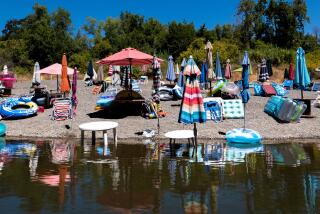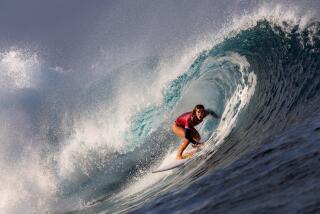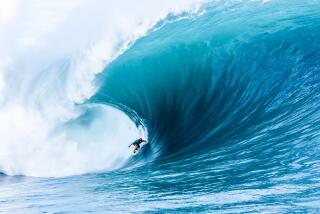Great Read: On a chilly beach in Russia, an unlikely surf culture takes root
- Share via
PETROPAVLOVSK, Russia — Nine time zones and more than 4,000 miles from Moscow, the Kamchatka Peninsula seems like one of the least accessible and hospitable places on Earth. No roads link the region to the Russian mainland. Active volcanoes loom over the land. The waters off the coast don’t hit 50 degrees, even in summer.
But down on the beach, overlooking the windy North Pacific, Anton’s surf hut is open to visitors. Plenty of them.
“There was nothing here five years ago,” says Aleksei Suvorov, 29, one of the surfers spending the summer at the hut. “Now, on the weekends when it’s hot, you can’t find a place to sit. There are traffic jams. People who have been to America say it’s like California.”
The hut stands in the dune grass on Khalaktyrskii (pronounced Ha-lak-TIR-sky) Beach, a strip of black sand littered with surfboards and rows of colorful tents. Jerry-built out of wood and canvas, the hut serves as the center of a vibrant surfer culture that rose from humble origins in the late ‘90s to become a fixture of summer life here in Petropavlovsk, the peninsula’s capital.
On a sunny Sunday afternoon in August, air temperatures at Khalaktyrskii hover at a relatively balmy 75, with the water temperature inching up to around 48, about 20 degrees cooler than a typical Southern California surf spot in August. With light offshore winds, the waves break in long, even segments along the beach. Nearly a dozen surfers in wetsuits bob in the chest-high swell.
The beach is crowded with young families circulating between the sand and a boardwalk built by the local government last year. A weaker ruble has encouraged Russians to vacation domestically rather than abroad this year, and tourists from Moscow and other cities in western Russia are mixed in with the local crowd.
Just down the beach from the new boardwalk, the surf hut also bustles with activity, as the best boarders prepare for the city surfing championship that afternoon.
Anton Morozov, 33, a Kamchatka local whose curly hair and beard have grown out after a summer on the beach, is the hut’s owner, as well as the competition’s organizer.
“There are three stereotypes that I fight against,” he explains before the competition, his soft voice masking his determination to popularize surfing here. “People think there are no good waves in Russia, that the water is too cold, and that you can’t get a wetsuit or board here.”
Morozov, whose last name means “frost,” did acknowledge that it gets chilly in winter, when the water temperature drops to 28 — 4 degrees below freezing.
“So far,” he says, “not many people are willing to go out with me.”
::
Russian surfing owes its origins to snowboarders who, after the fall of the Soviet Union, learned about surfing while abroad and brought surfboards home with them. Since the ‘90s, surfing groups have taken root on the coast of the Baltic Sea near St. Petersburg, on the Black Sea coast at Sochi and around Vladivostok on the Sea of Japan.
“But on the sea, you need a storm for good surf,” Morozov says matter-of-factly. “Here, we are on the ocean.”
Morozov says that Kamchatka has a variety of waves, including reef and point breaks. But the earliest generation of Russian surfers couldn’t master them.
“The first surfers came here thinking it would be a mecca for waves,” Morozov says. “But they didn’t know what they were doing, and they had a tendency to blame their problems on the surroundings — the waves, the beach, even the locals.”
Sergei Nefedov, a kite surfer who splits his time between Alaska and Kamchatka, is less diplomatic about the record of Kamchatka’s surf pioneers.
“Early surfers here were not professional,” he says. “They would come during storms when the waves were huge, get hurt and not want to come back.”
In 1997, one group from Moscow, apparently defeated by Kamchatka’s breakers, left their boards and wetsuits behind when they went home, unwittingly planting the seeds of a local surfing culture.
At the time, Morozov was still living with his parents on the opposite side of the peninsula, in a farming town on the calmer Sea of Okhotsk.
“When I was younger, I was constantly walking around down at the beach. Then a school friend, an athlete, lent me a cassette of the surfing movie ‘In God’s Hands,’” Morozov says, referring to a 1998 cult classic about three surfers searching for the perfect wave. “I must have watched it 500 times.”
In the early 2000s, Morozov tracked down a wetsuit and one of the boards left behind by the Muscovites and jumped into the water. But surfing didn’t come as naturally to him as he had hoped.
“This was before the Internet; there wasn’t any information to go on, and besides, I was afraid to go into the ocean,” Morozov says. “But eventually another friend found an instructional surfing CD from France; we figured out what it was saying, and it helped.”
A visit by American surfing legend Tom Curren to Kamchatka in 2004 was another watershed moment for Morozov. Although he knew nothing about the trip when it happened, he later saw a video of Curren riding Kamchatka’s waves and realized the area had vast potential for a skilled surfer.
As Morozov gradually progressed, he began to introduce others to the sport. Acquaintances he made while snowboarding in the winter proved particularly eager to join.
“Anton invited me to try surfing out here,” says Suvorov, a professional snowboarder who met Morozov 15 years ago. “Then I started to surf on my own in the Sea of Japan, from my home in Khabarovsk. It means driving 600 miles round trip; you have to wake up at 4 a.m., you can surf for two hours, and then you have to head home. But I would do it.”
Morozov founded his own surfing school in Kamchatka in 2009. These days (in summer, that is) he has up to six students a day, almost all of whom are Russian. He also introduces the area to foreign professional surfers who have heard rumors of the peninsula’s steady surf and decided to hazard a trip.
Morozov’s school has been so successful in anchoring a local surfing culture that this summer he was able to organize three surfing competitions with the local government’s cooperation: an open city competition, city finals and an upcoming championship with competitors from neighboring regions of Russia.
At the city finals, Morozov winds up handily defeating the competition. All four surfers ride on training longboards, and Morozov, moving deftly up and down his board, scores more points than his competitors, who focus on catching waves and staying with them.
If the surfers are, as a group, not yet highly experienced, the same is true of the judges. Tatiana Surdyayeva, an employee at the Moscow office of the Quiksilver surfwear company, came to Petropavlovsk with co-workers to try surfing for the first time. After three days in the water, she was offered a judge’s seat at the event tent by Morozov.
“It’s not that hard to judge, though,” she says cheerfully. “Just watching the surfers, it’s clear what you have to do.”
Morozov says that although he gets by with his income from surf rentals and lessons, he doesn’t make enough to invest in new facilities. Yet he says he wants to keep cultivating the sport in Kamchatka, especially among younger people.
“We’re establishing a camp for kids,” he says, “where we can give them some history and educate them from childhood to look at things differently, to have a love for the ocean.”
As Morozov busies himself setting up for his competition, a group of beginners tumble in the nearby waves.
Staggering out of the freezing, churning water, 16-year-old Ruslan Shiryayev appears ecstatic after his first time on a board, exclaiming, “I don’t know what I was doing my whole life!”
Hannon is a special correspondent.
More to Read
Sign up for Essential California
The most important California stories and recommendations in your inbox every morning.
You may occasionally receive promotional content from the Los Angeles Times.










